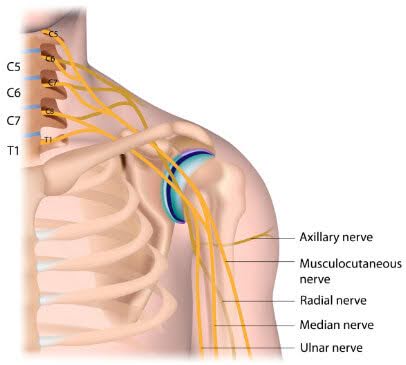What Are Common Treatment Options for a Brachial Plexus Nerve Injury?

Before your fingertips can tie your shoelaces into bunny loops and a knot, your brain starts the process by sending them instructions. Though you probably don’t give it a second thought, this movement is only possible because of a group of nerves known as the brachial plexus. If these nerves get pinched, stretched, or cut, it causes a condition known as a brachial plexus nerve injury. This damage makes simple movements using your arm and hands (like lacing up a pair of sneakers) challenging or impossible.
It’s possible to injure this complex network of nerves without even knowing you did so, meaning the first sign there might be an issue is your arm or hand not working correctly. Keep reading to learn more about the signs of a nerve injury, how this condition is diagnosed, and which advanced nerve treatment options are available.
Brachial Plexus Nerve Injury Causes
Brachial plexus injuries can vary in their seriousness. Some are mild and get better by themselves in a few weeks or months. But when the injury is more complex, like if the nerve has been torn, it might not completely heal, even if you have nerve repair surgery.
Brachial plexus problems can develop for many different reasons. Here’s a quick look at some examples of what types of trauma can cause this type of nerve injury:
Motorcycle and Car Accidents: A severe crash can violently jerk your body around, causing your nerves to get stretched or torn. In some cases, your brachial plexus may also become cut or damaged by objects like broken glass, shards of plastic, or twisted metal.
Sports Injuries: In high-energy sports, forceful impacts and bad falls can stretch and squeeze your brachial plexus and injure the nerves in your neck and shoulder area.
Medical Procedures and Treatments: Sometimes, your brachial plexus can get injured during surgery if your position inadvertently puts too much pressure on your nerves or stretches them for a long time. Additionally, cancer and radiation treatments may cause trauma to your brachial plexus.
Falls: You can stretch and damage your brachial plexus after a rough tumble where you forcefully land on your neck or shoulder. And, if you crash onto something jagged or uneven, you may also accidentally cut your nerves.
Gunshot and stabbing wounds: Brachial plexus injuries also can result after a bullet or knife that goes through—or close—to your nerve.
Birth Injuries: Sometimes, with especially difficult vaginal deliveries, a baby’s shoulders get squeezed so much that their brachial plexus nerves are injured; however, this damage occurs less than 1% of the time during childbirth.
Brachial Plexus Nerve Damage: How It’s Identified
Typically, diagnosing nerve damage symptoms involves reviewing your medical history, conducting a thorough physical exam (by checking for signs of weakness, numbness, and tingling), and completing diagnostic tests, such as:
- Magnetic resonance imaging (MRI)
- Electromyography (EMG) and nerve conduction studies (NCS)
- Computed tomography (CT) scans
Diagnostic tests like these help a specialist accurately diagnose your nerve injury and determine the extent of the damage to your brachial plexus. These findings enable a specialist to recommend the best possible treatment options.
Find the Source of Your Nerve Pain With a Testing Appointment
Brachial Plexus Nerve Injury Treatment
Looking at care options from a high level, there are two primary avenues for fixing damaged nerves: conservative care and surgical interventions. The best treatment plan for your condition will depend on many factors, including the severity of your injury.
From physical and/or occupational therapy and medication to intricate surgical procedures, each method provides different benefits when it comes to helping most patients with brachial plexus nerve damage regain a reasonable amount of function.
Conservative Care
Common non-surgical treatments for brachial plexus injuries include physical/occupational therapy, medication (pain management), and rest. These approaches can be effective, especially for milder injuries, helping to restore function and alleviate pain.
Surgical Interventions
Here are some of the ways that specialists treat the most complex brachial plexus nerve injuries that require intricate surgery:
Nerve Transfers
A patient’s healthy and undamaged nerves from unaffected parts of the brachial plexus or other sources (such as the rib cage or upper shoulder and back) can be rerouted to injured nerves to reawaken paralyzed muscles.
Nerve Grafts
A surgeon may use nerve grafts to replace a patient’s damaged nerves and help them grow back.
Tendon Transfers
Tendons that remain functional can be rerouted to improve mobility and function if a patient has weakened or paralyzed muscles from a nerve injury.
Muscle Transfers
Some patients may be candidates for moving healthy muscles from other body parts into the arm.
Joint Fusions
In some cases, a surgeon may fuse a patient’s joints that have lost mobility or weak motion as a way to provide stability.
Explore Surgical Options for Healing Brachial Plexus Injuries
Why Prompt Diagnosis and Treatment Matter
Sometimes, the first sign something is off might happen out of the blue when you try to do something you’ve always done before without a second thought, whether that’s struggling to wave “hi” to your neighbor, being too weak to grab a snack from your fridge, being unable to lift your phone, or not noticing the heat when pulling warm towels from your dryer.
Ignoring minor discomfort and signs that something’s off can be tempting. However, when you delay getting help from a medical professional, it affects your quality of life and may also:
- Limit treatment options
- Lead to secondary problems (e.g., joint stiffness, muscle atrophy, etc.)
- Increase the risk of permanent nerve damage
- Make the rehabilitation process take longer and more challenging
- Exacerbate pain and discomfort
Everyday life is hard enough as it is. You don’t have to live with challenges from your shoulder, arm, or hand not functioning as it used to—whether that’s due to a brachial plexus nerve injury or something else.
There’s a better way.
To learn more about care options that may help you improve your strength and restore sensation, make an appointment with an expert or—better still—a group of experienced nerve specialists with all the training necessary to determine the underlying cause of your symptoms. It’s only from that point forward that you can gain a true understanding of what’s happening, explore treatment options, and start the healing process.
IHTSC Specializes in Treating Brachial Plexus Nerve Injuries
Each person’s body heals differently. Age, overall health, and even your body’s response to treatments can influence nerve injury recovery. That’s why prompt treatment of these injuries requires careful diagnosis and a customized approach.
If a brachial plexus injury has reduced your mobility, we invite you to schedule a consultation to explore treatment options that may provide you with functional improvements to improve your quality of life.
The multidisciplinary team of surgeons at IHTSC’s Nerve Clinic—nationally and internationally renowned experts in brachial plexus neurology—provides the most up-to-date treatments and advanced surgical solutions for patients with complex nerve injuries. You deserve to move through everyday life—more comfortably and easily—after a brachial plexus nerve injury. Make an appointment today for team-based nerve care.
You Might Also Like:
Disclaimer: The materials on this website have been prepared for informational purposes only and do not constitute advice. You should not act or rely upon any medical information on this website without a physician’s advice. The information contained within this website is not intended to serve as a substitution for a thorough examination from a qualified healthcare provider. The display of this information is not intended to create a health care provider-patient relationship between the Indiana Hand to Shoulder Center and you.



